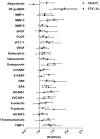Novel Biomarkers to Improve the Prediction of Cardiovascular Event Risk in Type 2 Diabetes Mellitus
- PMID: 27247335
- PMCID: PMC4937255
- DOI: 10.1161/JAHA.115.003048
Novel Biomarkers to Improve the Prediction of Cardiovascular Event Risk in Type 2 Diabetes Mellitus
Abstract
Background: We evaluated the ability of 23 novel biomarkers representing several pathophysiological pathways to improve the prediction of cardiovascular event (CVE) risk in patients with type 2 diabetes mellitus beyond traditional risk factors.
Methods and results: We used data from 1002 patients with type 2 diabetes mellitus from the Second Manifestations of ARTertial disease (SMART) study and 288 patients from the European Prospective Investigation into Cancer and Nutrition-NL (EPIC-NL). The associations of 23 biomarkers (adiponectin, C-reactive protein, epidermal-type fatty acid binding protein, heart-type fatty acid binding protein, basic fibroblast growth factor, soluble FMS-like tyrosine kinase-1, soluble intercellular adhesion molecule-1 and -3, matrix metalloproteinase [MMP]-1, MMP-3, MMP-9, N-terminal prohormone of B-type natriuretic peptide, osteopontin, osteonectin, osteocalcin, placental growth factor, serum amyloid A, E-selectin, P-selectin, tissue inhibitor of MMP-1, thrombomodulin, soluble vascular cell adhesion molecule-1, and vascular endothelial growth factor) with CVE risk were evaluated by using Cox proportional hazards analysis adjusting for traditional risk factors. The incremental predictive performance was assessed with use of the c-statistic and net reclassification index (NRI; continuous and based on 10-year risk strata 0-10%, 10-20%, 20-30%, >30%). A multimarker model was constructed comprising those biomarkers that improved predictive performance in both cohorts. N-terminal prohormone of B-type natriuretic peptide, osteopontin, and MMP-3 were the only biomarkers significantly associated with an increased risk of CVE and improved predictive performance in both cohorts. In SMART, the combination of these biomarkers increased the c-statistic with 0.03 (95% CI 0.01-0.05), and the continuous NRI was 0.37 (95% CI 0.21-0.52). In EPIC-NL, the multimarker model increased the c-statistic with 0.03 (95% CI 0.00-0.03), and the continuous NRI was 0.44 (95% CI 0.23-0.66). Based on risk strata, the NRI was 0.12 (95% CI 0.03-0.21) in SMART and 0.07 (95% CI -0.04-0.17) in EPIC-NL.
Conclusions: Of the 23 evaluated biomarkers from different pathophysiological pathways, N-terminal prohormone of B-type natriuretic peptide, osteopontin, MMP-3, and their combination improved CVE risk prediction in 2 separate cohorts of patients with type 2 diabetes mellitus beyond traditional risk factors. However, the number of patients reclassified to a different risk stratum was limited.
Keywords: biomarker; cardiovascular disease prevention; cardiovascular disease risk factors; risk stratification.
© 2016 The Authors. Published on behalf of the American Heart Association, Inc., by Wiley Blackwell.
Figures


References
-
- Guariguata L, Whiting DR, Hambleton I, Beagley J, Linnenkamp U, Shaw JE. Global estimates of diabetes prevalence for 2013 and projections for 2035. Diabetes Res Clin Pract. 2014;103:137–149. - PubMed
-
- Sarwar N, Gao P, Seshasai SRK, Gobin R, Kaptoge S, Di Angelantonio E, Ingelsson E, Lawlor DA, Selvin E, Stampfer M, Stehouwer CDA, Lewington S, Pennells L, Thompson A, Sattar N, White IR, Ray KK, Danesh J. Diabetes mellitus, fasting blood glucose concentration, and risk of vascular disease: a collaborative meta‐analysis of 102 prospective studies. Lancet. 2010;375:2215–2222. - PMC - PubMed
-
- Haffner SM, Lehto S, Rönnemaa T, Pyörälä K, Laakso M. Mortality from coronary heart disease in subjects with type 2 diabetes and in nondiabetic subjects with and without prior myocardial infarction. N Engl J Med. 1998;339:229–234. - PubMed
-
- Howard BV, Best LG, Galloway JM, Howard WJ, Jones K, Lee ET, Ratner RE, Resnick HE, Devereux RB. Coronary heart disease risk equivalence in diabetes depends on concomitant risk factors. Diabetes Care. 2006;29:391–397. - PubMed
Publication types
MeSH terms
Substances
LinkOut - more resources
Full Text Sources
Other Literature Sources
Medical
Research Materials
Miscellaneous

